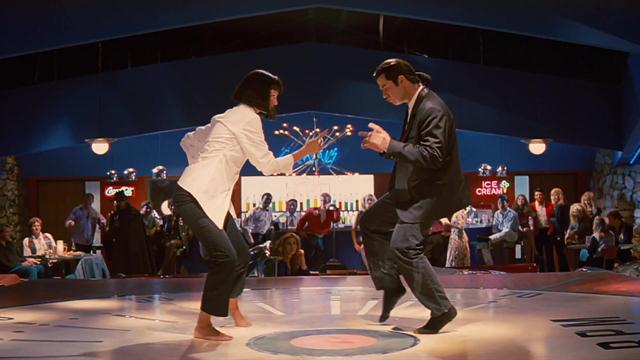
In a Musical, the world has certain exceptions. Intricated in the genre are tons of characters suddenly bursting into song and dance routines. We don’t think twice, it’s a given. But when a film is void of any other musical trends and is of a different genre, that is: war drama, thrillers, science-fiction and so on- leads it to be firmly defined as a non-musical film.
Except for the occasional jiggy that brings everybody together at the end.
So, what happens when you splice two complete genres which obey different rules together for just a couple of minutes in your movie? What happens are some very memorable, iconic moments in cinema, and meme-able gifs.
Below is a list of unsuspecting dancing scenes in non-musical movies that seem to defy genre constraints and utilise movie-making in its capacity to bend the laws of reality and pump up the volume of the song – at least for one perfectly rehearsed and choreographed piece of performative art.
1. Beau Travail (1999) dir. Claire Denis
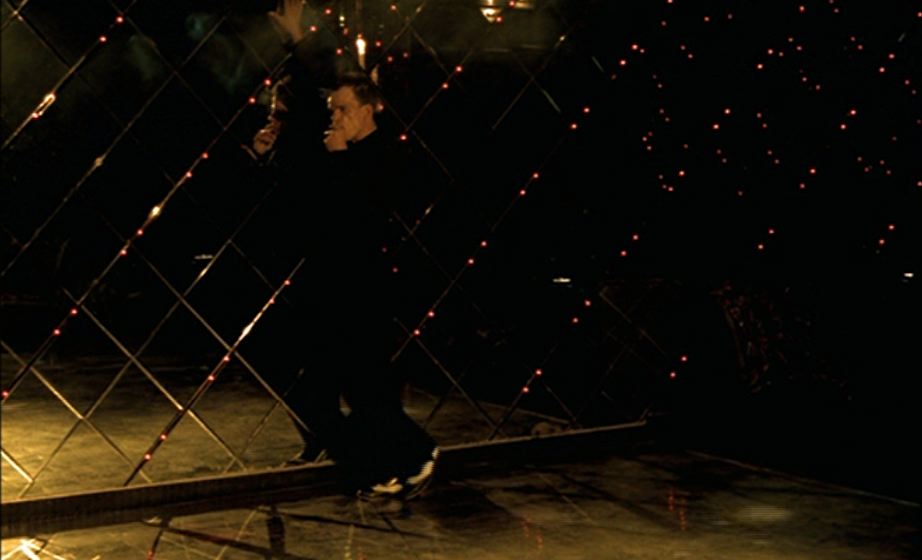
Literally translated into “Good Work”, Claire Denis’ French drama is loosely based on Herman Melville’s 1888 novella “Billy Budd”, adapting the original Royal Navy set-up during the French Revolution to the French-occupied African county of Djibouti – where soldiers in the French Foreign Legion train in absolute heat.
The whole film itself is the memory of Chief Adjutant Galoup (ever-dedicated Denis Lavant) who is writing his memoirs in Marseille about when he led his section of men in Djubouti, including the beautiful and affable Giles Sentain (Grégoire Colin), whom Galoup soon becomes intensely envious of in such a way that it is often perceived to be rooted in repressed homoerotic desire.
As Hardy writes; “The stark desert, with its endless stretch of sand and jagged rocks beneath a rolling blue sky, provides a breath-taking canvas for Denis, who captures the rituals of exercise, marching, showering, and bonding with a poet’s eye. In her carefully constructed scenes, everyday routines are transformed into gracefully choreographed dances.”
Indeed, the calisthenics have an air of delicacy and precision that mirror ballet’s sternness and gymnastics’ core strength. The men’s sweat reflects the sun, and their muscles pulsate. Denis’ 35mm long takes hypnotises its audiences which culminate in a dance sequence which can only be described as simultaneously baffling and amazing.
Shot in a singular take in an interior dance studio clad in twinkling fairy lights and a massive mirror, Chief Galoup flexibly moves and smokes to the beats of Corona’s ‘90s hit “The Rhythm of the Night”. Alone and unwatched, his bodily intensity rises and falls continuously until the credits roll.
(Bonus: Denus Lavant dances crazy gymnastics and acrobatic dance moves in Leos Carax’ surrealist “Holy Motors” (2012) and “Mauvais Sang” (1986), the latter in which he grooves to David Bowie’s Modern Love. Lavant also acts as a moonwalking Michael Jackson impersonator on the streets of Paris in Harmony Korine’s “Mister Lonely” (2007). The actor is known for his elastic, slapstick moves, so many of his films include some sort of performative art piece).
Literary References:
Ernest Hardy. 1001 Movies to See Before Your Die (2014).
2. Bande à part (1964) dir. Jean-Luc Godard

Godard’s iconic French New Wave film, released in North America with the title “Band of Outsiders”, follows three people as they plan and carry out a robbery. There’s Odile (Anna Karina), Franz (Sami Frey) and Arthur (Clause Brasseur). Odile unwittingly tells Franz, who she has met in their English class, about the large pile of money stashed in the Parisian villa she lives in with her aunt and Mr. Stolz. The men plan to steal it and since Odile has a crush on Arthur, she goes along with it.
The three are in a café and after a minute of silence (well, technically 36 seconds), Franz puts on a record from the jukebox, and Michel Lagrand’s soul piano music emanates. Arthur and Odile decide to dance and Franz shortly joins them. The trio perform a rehearsed dance in the middle of the café in synchrony while Godard’s voice over reveals the inner thoughts and feelings of our characters.
“Arthur keeps watching his feet, but his mind’s on Odile’s mouth and her romantic kisses… Odile is wondering if the boys notice her breasts moving under her sweater… Franz thinks of everything and nothing. He wonders if the world is becoming a dream or if the dream is becoming the world.”
The dance has often been referred to simply as the “Madison dance”, even though it bears little resemblance to the actual ‘Madison’ line dance. They snap, clap and move their feet in a square formation, the moves are repeated and repeated until the characters get tired of it. The actors rehearsed the dance sequence in nightclubs and bars in Paris’ Latin District in preparation for the four minute uncut scene.
(Bonus: In Hal Hartley’s 1992 “Simple Men”, the characters perform a synchronised dance scene which is particularly reminiscent of Godard. Initially with two men and one woman (who is of course wearing a traditionally new wave black-and-white striped top and a subversively short fringe like Karina) dance in a café to Sonic Youth’s “Kool Thing”. Hartly also uses an impromptu music-less dance sequence in his 1991 “Surviving Desire”).
(Double Bonus: Roger Michell’s 2013 “Le Week-End” pays significant homage to the Madison dance with actors Jim Broadbent, Lindsey Duncan and Jeff Goldblum recreating it).
(Triple Bonus: Also referenced and recreated by Zoeey Deschanel, Jena Malone and Lou Taylor Pucci in black-and-white in Martin Hynes’ 2007 indie road flick “The Go-Getter”).
3. Foxtrot (2017) dir. Samuel Moaz
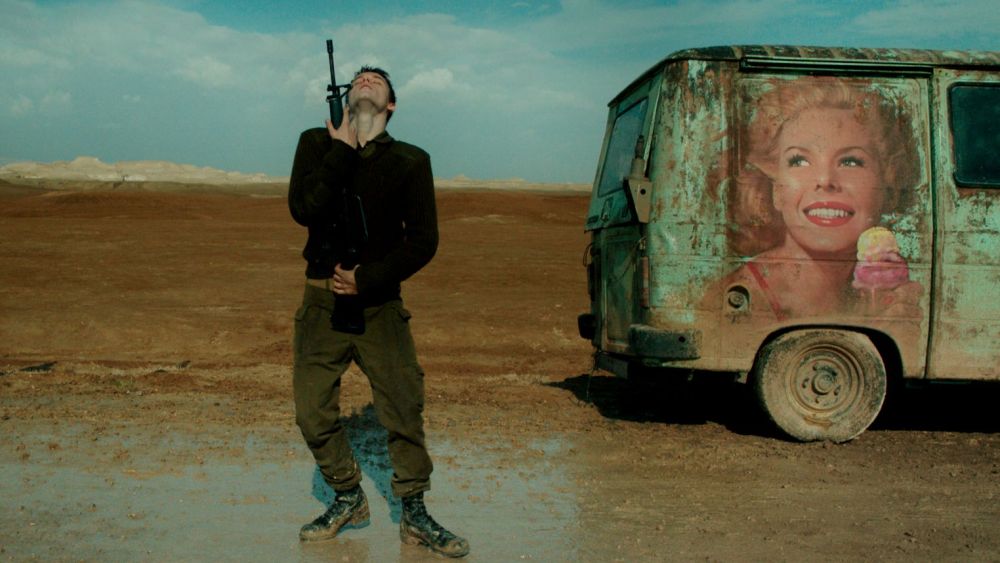
Opening with the paralysing news that their son, Jonathan (Yonathan Shiray) is dead, Michael (Lior Aashkenazi) and Daphna (Sarah Adler) struggle to come to grips with their new reality that now involves funeral plans and crying relatives. Disillusioned, the traumatic events loop round the plot of the son’s experience in the military and the parents’ grief which are seamlessly stitched together by spontaneous dancing, animated illustration sequences, and horrific circumstances.
Jonathan is (or was) a soldier in the Israeli Defense Forces where he and his fellow brothers-in-arms man a desolate checkpoint in the middle of a rutted desert. Bored and in primitive conditions, the men spend their time thinking about what they can do to fill up their time. This leads to one of the only entertainments available to them: dance. In a spontaneous sequence, Jonathan solely performs a variation of the foxtrot to Perez Prado’s “Que Rico El Mambo” (also referred to as “Mambo Jambo”), partnering up with his loyal shotgun.
Maoz effortlessly reinvents typically complex storytelling techniques such as multiple-perspectives and non-linearity into a three-act structure. Often punctuated by bird’s eye view shots and innovative pans, the film detaches itself and becomes a passive witness to the trauma experiences by the characters within the film. Maoz manages to obtain a rare balance of heart-stopping, gasp-worthy moments and hilarious comic relief. The subtle scenes have the capacity to resonate universally, focusing on the emptiness in times where one tries to relieve boredom and fill up the blank space.
The title unveils not one, but two aspects of the tale; simultaneously referring to the military jargon and the dance. “Foxtrot” knows exactly how much or how little to expand about each subject and storyline, dedicating an entire sequence to how a sticky 1970s Playboy magazine has replaced a priceless Bible from World War II as the new family heirloom and using slivers of time to explain major plot points.
The film was screened in the competition section of the 74th Venice International Film Festival, where it won the Grand Jury Prize.
4. Dogtooth (2003) dir. Yorgos Lanthimos
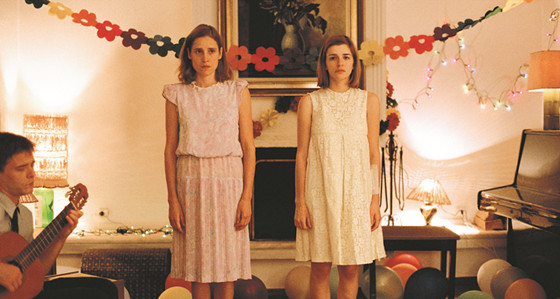
Yorgos Lanthimos’ Greek drama follows an unnamed husband and wife who have kept their three adolescent children in their property for all their lives. The children are completely ignorant of the outside world and are told that they can only leave once they lose their fictitious dogtooth.
Unsatisfied, the elder daughter (Angeliki Papoulia) barters for Hollywood film tapes (one of which is Adrian Lyne’s “Flashdance”) with her brother’s assigned prostitute Christina in exchange for oral sex. She becomes fixated by the world presented onscreen and now knows there’s a world beyond her prison.
Set up against grounded rainbow balloons, looping fairylights, and a sloping flower banner, one of the last scenes of the strange film is energised by horrifying incongruency. The elder daughter recreates Flashdance’s dance routine to the twang of her brother’s acoustic guitar.
With a domineering look that never breaks and a tense atmosphere full of restriction and confusion, the elder daughter’s long-felt house-bound suffocation is finally let out in an alarming set of exertive movements that nobody quite understands. Her parents are disturbed, so is her younger sister (Mary Tsoni) who initially dances with her until she can’t keep up with her sister’s aggressive, erratic movements that feel unnervingly out of place within the film’s context.
Yorgos Lanthimos often utilises strange and out-of-place ballet like movements that act as a form of hysteria in his characters. In the ‘90s, he used to direct videos for Greek dance-theatre companies and music videos, explaining his expertise in capturing dance.
Most of his films have some element of unexpected movements that are reminiscent of “excited catatonia” of which sufferers move their body in repeated, stereotyped and bizarre movements with no end-goal; simply a physical manifestation of hyperactivity and impulsiveness from some other underlying disorder. Or in his films’ cases – the strange worlds the characters’ lives in are so limiting and restraining that dance is the only way to rebel.
The film took home the Prix Un Certain Regard prize at Cannes and was nominated for Best Foreign Language Film at the Academy Awards.
(Bonus: Lanthimos’ absurdist 2015 film “The Lobster” is also full of awkward couple dance moves and the epic solo earphone ecstasy).
5. Pulp Fiction (1994) dir. Quentin Tarantino
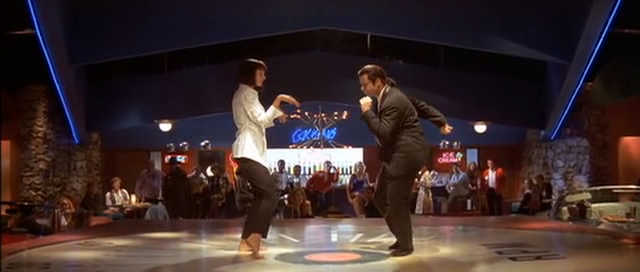
How to explain the “hellsapopinish”-ness of Jack Rabbit Slim’s? Well, as Tarantino puts it in his screenplay; “In the past six years, 50’s diners have sprung up all over L.A., giving Thai restaurants a run for their money. They’re all basically the same.
Decor out of an “Archie” comic book, Golden Oldies constantly emanating from a bubbly Wurlitzer, saucy waitresses in bobby socks, menus with items like the Fats Domino Cheeseburger, or the Wolfman Jack Omelet, and over prices that pay for all this bullshit. But then there’s JACKRABBIT SLIM’S, the big mama of 50’s diners. Either the best or the worst, depending on your point of view.”
As soon as we’re here, Vincent (John Travolta) is quick to question what the hell kind of time machine place this is. Their vernacular immediately becomes reminiscent of the ‘50s lingo, with endearments like daddy-o and kitty-cat. Mia (Uma Thurman) tells him not to be a square- in so many words, at least.
We track Vincent through the intricate diner. The place is plastered in ‘50s movie posters (special mention: Attack of the 50 Foot Woman) and the waiters are all dressed up as ‘50s icons (Marilyn Monroe, Donna Reed, James Dean, etc.). Neon lights, checker print, toy race car set-ups, indoor umbrellas, car booths and tables – this diner is busy. Add to all this that there’s a massive dance floor in the centre of the diner. Hint, hint. But for now, Ricky Nelson replica sings a tune.
Mia’s reserved them a Chrysler booth to sit in. She shrugs off her Agnés B double-breasted, velvet collar coat (she’s intentionally supposed to look like a female Reservoir Dog) and stuffs it into the corner.
Mia: What do you think?
Vincent: I think it’s like a wax museum with a pulse.
Their waiter is Buddy Holly (a delightful Steve Buscemi cameo – hilarious considering his Mr. Pink hates tipping the service profession) who takes their order of one Douglas Sirk steak (bloody as hell), one Durward Kirby burger (also bloody – in tone with the rest of the film), one vanilla coke, and one $5 vanilla shake (Martin and Lewis = Vanilla; Amos ‘n’ Andy = Chocolate; flavours replaced by the binary races of comedy duos).
Vincent is critical of the price of the iconic shake. Mia’s crimson nails retrieve her Red Apple cigarettes, but asks for a fresh, rolled one off Vincent instead. They talk about Amsterdam, her television show pilot, and the dynamics of conversation. Bonds form over rumbling Link Wray twangy power chords.
But now for the world famous Jack Rabbit Slims “Twist Contest”, which Mia is eager to win. The two of them go to the main stage, take off their shoes (it’s Tarantino, so of course there’s a lot of feet) and twist to Chuck Berry’s 1964 “You Never Can Tell”. The dance itself is heavily inspired by Fellini’s “8 ½”, (1963) in which Gloria Morin (similarly fringed-black-bobbed Barbara Steele) and Mario Mezzabotta (Mario Pisu) dance in a humoristic twist in contrast to the other traditional dance partners in the background.
The whole thing lasts for a couple of seconds with Steele mainly taking the lead and Pisu just elatedly smiling, but it’s enough time to make an impact on Tarantino. The sequence also pays significant homage to Godard’s “Bande à part” (Band of Outsiders, 1964), after which Tarantino also named his production company after.
“Everybody thinks that I wrote this scene just to have John Travolta dancing (referencing Saturday Night Fever, 1977). But the scene existed before John Travolta was cast. But once he was cast, it was like, “Great. We get to see John dance. All the better.” … My favorite musical sequences have always been in Godard, because they just come out of nowhere. It’s so infectious, so friendly. And the fact that it’s not a musical, but he’s stopping the movie to have a musical sequence, makes it all the more sweet.” Indeed, Tarantino illustrates the point of this entire article.
Costume designer Betsy Heimann used Agnés B in both Reservoir Dogs (1992) and Pulp Fiction, utilising black suits to intentionally echo the French New Wave look. Despite a meagre budget (most of the film’s money was spent to create Jack Rabbit Slims), Heimman managed to procure excellent outfits from B.
After the random twist dance, Mia continues to dance and sing by herself back at her house to Urge Overkill’s “Girl, You’ll Be A Woman Soon”.
(Bonus: In “Reservoir Dogs” (1992), Mr. Blonde/Vic Vega (Michael Madsen) who is supposedly Vincent’s brother, tauntingly dances to “Stuck in the Middle with You” by the Stealers Wheel on the radio while casually torturing and cutting off a hostage’s ear. A scene heavily reproduced in popular culture).
(Double Bonus: Tarantino’s exploitation horror “Death Proof” (2007) Arlene/Butterfly (Vanessa Ferlito) gives a seductive lap dance to stuntman Mike McKay (Kurt Russell) to The Coasters’ 1956 doo-wop song “Down in Mexico”. In red-toenail exposing flipflops).
Literary References:
Christopher Laverty. (2017). Fashion in Film, p.9-13. Laurence King Publishing.
6. Do The Right Thing (1989) dir. Spike Lee
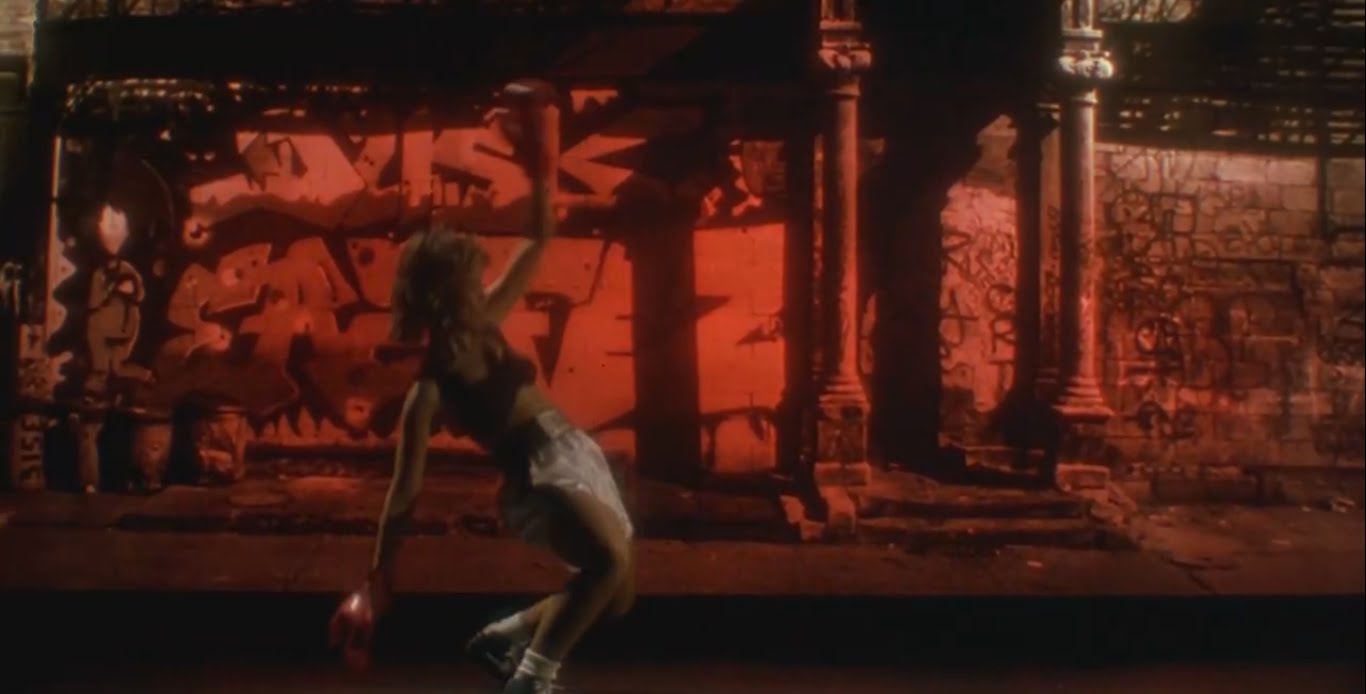
Definitely one of the best opening sequences in cinema history, Spike Lee’s Brooklyn tale starts off with a four-minute intense dance routine (that took eight hours to film), intercut in various locations and in different outfits, performed by Tina (Rosie Perez) who is the girlfriend to protagonist pizza-delivery-man Mookie (Spike Lee) and the mother of their kid Hector.
Public Enemy’s hip hop groove “Fight the Power” blasts off as jump cuts of Tina in different dance positions in front of their Brooklyn block steps sets the quick pace the film takes in following the events of one solitary deadly-hot summer day in their neighbourhood and the rise to violence culminating at the end.
So, starting off with a furious Perez shadowboxing, cabbage-patching and running-man-ing with ragefully passionate facial expressions seems about right. Lee has said that the dance sequences from 1963 musical “Bye Bye Birdie” served as major inspiration in his consideration to start the film off with a dance number.
The title of the song is intrinsically important to the film, since even though their motivation is to fight the power, that is the abuse of power- they end up fighting each other instead. Public Enemy wrote the emblematic song for racial politics and civil rights exhortations at the request of Lee himself who wanted a theme to become a leitmotif for his film. Indeed, civil rights and racial tensions is at the core of this comedy-drama, the title itself stemming from a Malcolm X quotation that goes, “You’ve got to do the right thing.” Lee would later create a biopic about X (1992).
The rap incorporates the music of James Brown with various looping samples and references to African-American culture. Lee said; “”I wanted it to be defiant, I wanted it to be angry, I wanted it to be very rhythmic. I thought right away of Public Enemy”. Lee would subsequently direct two music videos for their song.
The song is also very prevalent in scenes with local Radio Raheem (Bill Nunn), a character who carries a boombox around the neighbourhood with the song playing loudly and representing Black consciousness. The song is now number 40 on the American Film Institute’s list of 100 years…100 songs.
7. The Breakfast Club (1985) dir. John Hughes
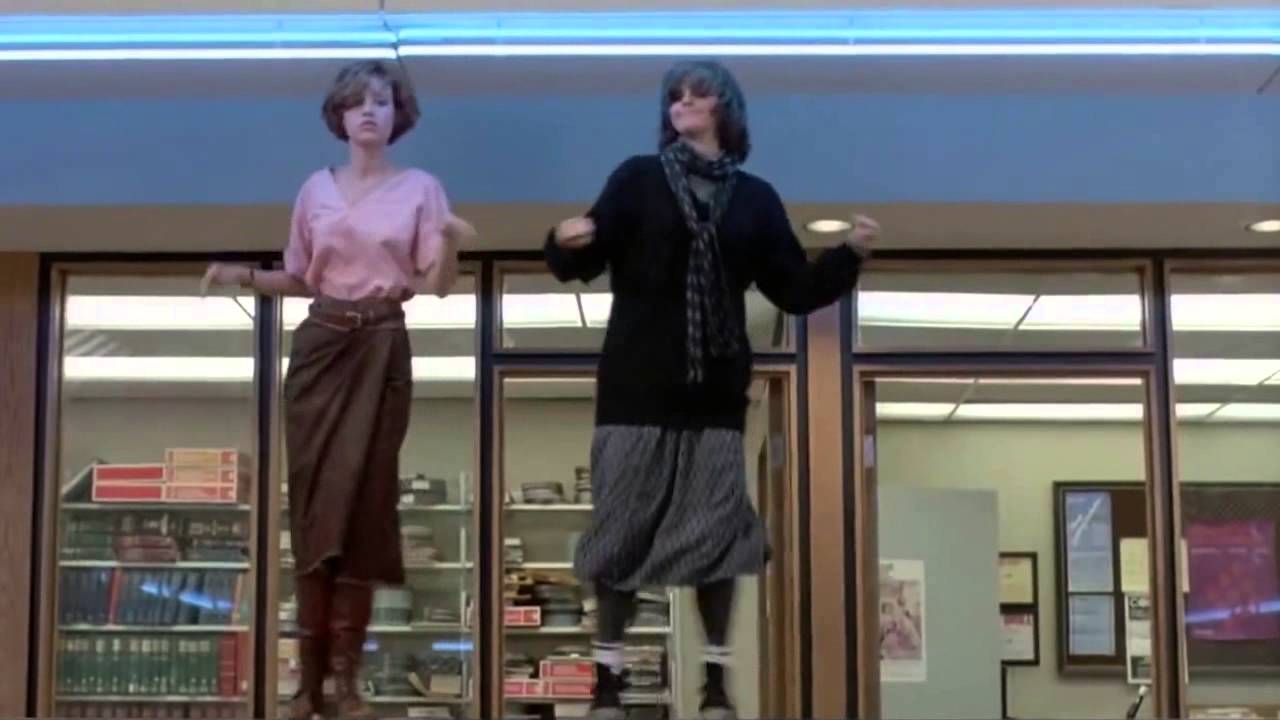
John Hughes’ classic teen flick “The Breakfast Club” follows a brain, an athlete, a basket case, a princess, and a criminal- or otherwise known as five high schoolers from severely different cliques who spend a Saturday morning in detention together for their individuals misbehaviours and gasp: end up bonding.
The theme song written for the film by Keith Forsey begins – “Don’t You (Forget About Me)” as the opening titling sequence ensues. Then a quote from David Bowie’s 1971 song “Changes” appears white on the black screen:
“And these children
that you spit on
as they try to change their worlds
are immune to your consultations.
They’re quite aware of what they’re going through.”
And obviously, this film being all about rebellion, the screen is shot and shattered into a million pieces, revealing the large concrete Shermer High School in the fictitious Shermer, Illinois (a location where many Hughes’ films are set). Brian i.e. the anagrammatic brain, the geek, the dork (Anthony Michael Hall) starts his voice-over in the form of a letter director towards their strict assistant principle (Paul Gleason). The film is entirely based in the school, primarily the library, giving the comedy-drama a constructed play-like structure that depends on characterisation, dialogue- and entirely random dance sequences.
Well, not so random. The dance is brought on by the group getting high on troublemaker John’s (Judd Nelson) secret dope supply from his locker. Somehow they all get away with loud music, drug fumes and general anarchy without rousing attention. Originally Claire (Molly Ringwald) was supposed to dance alone but since the actress was shy, Hughes got all the kids to jam out to the theme of Karla DeVito’s “We Are Not Alone”.
There’s furious headbanging, jumping, air-guitaring, shuffling feet and a couple of lifted dance moves from Madness’ ska “One Step Beyond” music video and album cover. The highly referenced climactic dance scene acts to release tension from all the dramatic tales told that morning – lots of things are promised to be covered, from parental abuse and Madonna-Virgin complexes to Richard Pryor stand-up and what kind of lunch they’re eating.
Initially proposed with the alternative titles; “Detention”, “The Lunch Bunch”, and “Library Revolution”, the title was ultimately named after Hughes’ heard his son’s friend refer to morning detention as that- the Breakfast club. Seven a.m. they are brainwashed, and by the end- they are liberated.
(Bonus: A close second dance scene of Hughes’ is in his 1986 comedy “Ferris Bueller’s Day Off” where Bueller (Matthew Broderick) dances and confidently lip-syncs in a massive parade to The Beatles’ cover of “Twist and Shout”).
8. Ex Machina (2014) dir. Alex Garland
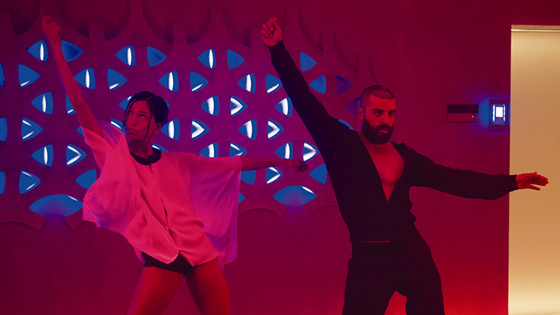
Alex Garland’s directorial debut follows Caleb (Domhnall Gleeson) a programmer who wins a company-wide and is invited by his 30-year-old prodigy CEO Nathan Bateman (Oscar Isaac) to administer the Turing test to an intelligent humanoid robot, a.k.a. Ava (Alicia Vikander).
This indie science-fiction psychological thriller has one of the most unexpected dance sequences in the history of cinema. With no set-up, no explanation, no reason to suspend disbelief and believe its musical roots – the dance is used primarily a distraction, rather than the typical tension-releasing trope. A smoke-screen, like the competition itself. Every move in this film is calculated, so is the dance any different?
After seeing live footage of an alarming interaction between Nathan and Ava, Caleb’s brow deepens in confusion at Nathan’s actions. He asks Nathan’s maid slash girlfriend (?) Kyoko (Sonija Mizuno), whose seemingly mute and doesn’t understand English, where the hell Nathan is. Confusion builds and an alcohol-glazed Nathan interrupts them.
What comes next is a series of rehearsed running-lawnmower and baseball throw dance moves set to immediately changed disco aesthetic and the unseen speakers emanating Oliver Cheatham’s “Get Down Saturday Night”. As Garland writes in his screenplay: “Caleb stands – frozen by the surrealism of what has just happened”. Indeed, the dance break acts as a surreal momentary tangent from the genre of the intensely psychological science-fiction.
The title derives from the Latin phrase “Deus Ex-Machina,” meaning “a God from a Machine,” a phrase that originated Greek tragedies. The only presence of the phrase in the film is a small labelled folder on Nathan’s desktop computer screen. The film is loosely based on Shakespeare’s play “The Tempest” and merges it together with Plato’s “Allegory of the Cave “and Frank Kackson’s “Knowledge Argument”. Creating a futuristic tale based on tragedies and thought experiment, Garland was subsequently nominated for Best Original Screenplay at the Academy Awards and at the BAFTAs.
(Bonus: On the film’s special features on its Blu-ray and DVD releases, there is an Easter Egg that shows an extended version of the dance).